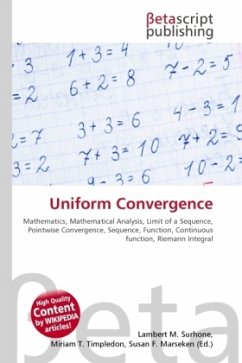Please note that the content of this book primarily consists of articles available from Wikipedia or other free sources online. For a class of predicates H,! defined on a set X,! and a set of samples x=(x_{1},x_{2},dots,x_{m}),!, where x_{i}in X,!, the empirical frequency of hin H,! on x,! is widehat{Q_{x}}(h)=frac{1}{m} {i:1leq ileq m,h(x_{i})=1} ,!. The Uniform Convergence Theorem states, roughly,that if H,! is "simple" and we draw samples independently (with replacement) from X,! according to a distribution P,!, then with high probability all the empirical frequency will be close to its expectation, where the expectation is given by Q_{P}(h)=P{yin X:h(y)=1},!. Here "simple" means that the Vapnik-Chernovenkis dimension of the class H,! is small relative to the size of the sample.In other words, a sufficiently simple collection of functions behaves roughly the same on a small random sample as it does on the distribution as a whole.








